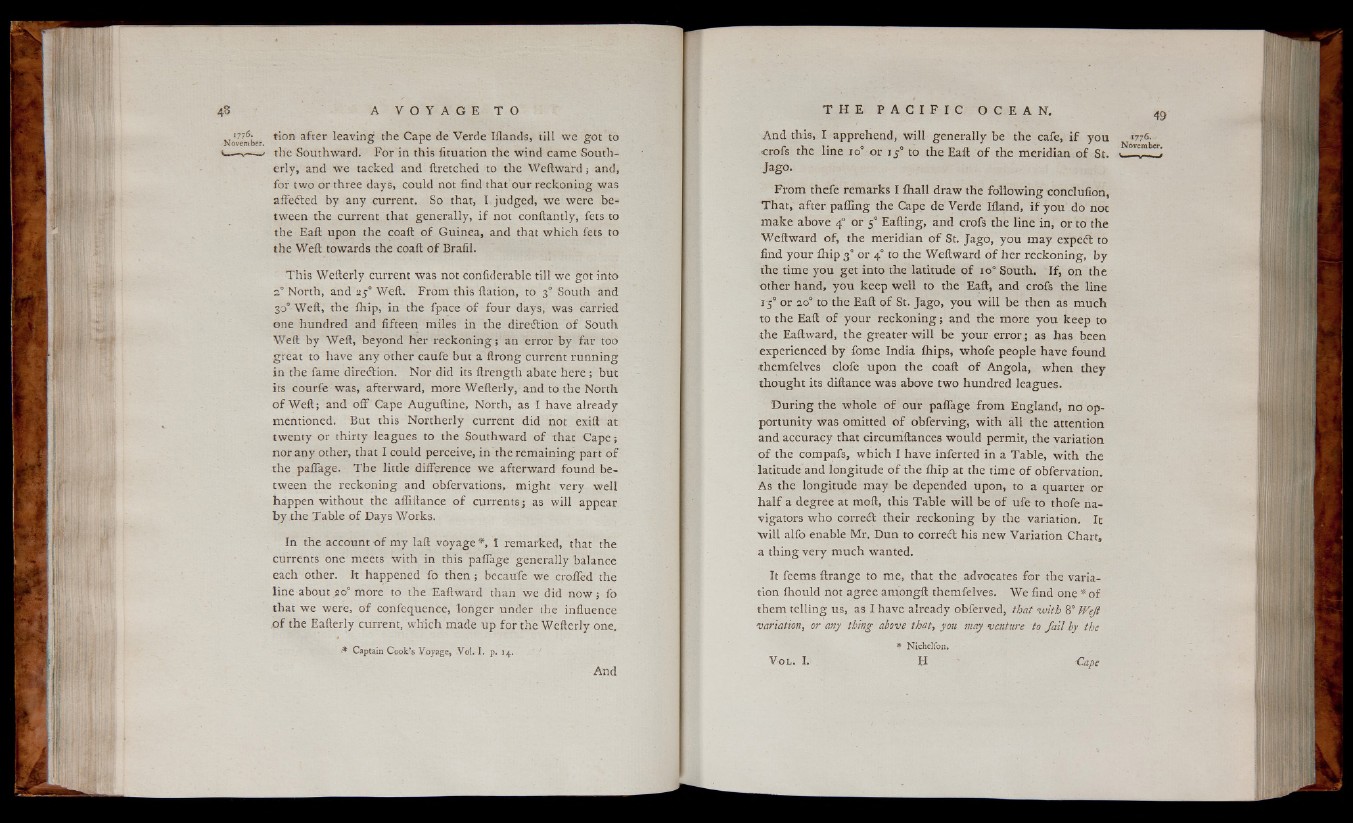
tion after leaving the Cape de Verde Iflands, till we got to
the Southward. For in this fituation the wind came Southerly,
and we tacked and ftretched to the Weftward; and,
for two or three days, could not find that our reckoning was
affefted by any current. So that, I judged, we were between
the current that generally, if not conftantly, fets to
the Eall upon the coaft of Guinea, and that which fets to
the Weft towards the coaft of Brafil.
This Wefterly current was not confiderable till we got into
2° North, and 25° Weft. From this ftation, to 3° South and
30° Weft, the fhip, in the fpace of four days, was carried
one hundred and fifteen miles in the direction of South
Weft by Weft, beyond her reckoning; an error by far too
great to have any other caufe but a ftrong current running
in the fame diredtion. Nor did its ftrength abate here ; but
its courfe was, afterward, more Wefterly, and to the North
o f Weft; and off Cape Auguftine, North, as I have already
mentioned. But this Northerly current did not exift at
twenty or thirty leagues to the Southward of that Cape;
nor any other, that I could perceive, in the remaining part of
the paffage. The little difference we afterward found between
the reckoning and ohfervations, might very well
happen without the alfiftance of currents, as will appear
by the Table of Days Works.
In the account of my laft voyage *, I remarked, that the
currents one meets with in this paffage generally balance
each other. It happened fo then ; becaufe we crofted the
line about 2a0 more to the Eaftward than we did now; fo
that we were, of confequence, longer under the influence
o f the Eafterly current, which made up for the Wefterly one.
Captain Cook’s Voyage* Vol. I. p. 14.
And
And this, I apprehend, will generally be the cafe, i f you >776-
crofs the line io° or ij'° to the Eaft of the meridian of St. .No!^ ber;
Jago.
From thefe remarks I ihall draw the following conclufion,
That,' after palling the Cape de Verde Ifland, i f you do not
make above 4“ or 50 Eafting, and crofs the line in, or to the
Weftward of, the meridian o f St. Jago, you may expeit to
find your fhip 30 or 4° to the Weftward o f her reckoning, by
the time you get into the latitude of 10° South. If, on the
other hand, you keep well to the Eaft, and crofs the line
15° or 20° to the Eaft of St. Jago, you will be then as much
to the Eaft of your reckoning; and the more you keep to
the Eaftward, the greater will be your error; as has been
experienced by fome India ihips, whofe people have found
•themfelves clofe upon the coaft o f Angola, when they
thought its diftance was above two hundred leagues.
'During the whole of our paffage from England, no opportunity
was omitted of obferving, with all the attention
and accuracy that circumftances would permit, the variation
o f the compafs, which I have inferted in a Table, with the
latitude and longitude of the fhip at the time o f obfervation.
As the longitude may be depended upon, to a quarter or
half a degree at mod, this Table will be of ufe to thofe navigators
who correct their reckoning by the variation. It
will alfo enable Mr. Dun to correft his new Variation Chart,
a thing very much wanted.
It feems ftrange to me, that the advocates for the variation
ihould not agree amongft themfelves. We find one * of
them telling us, as I have already obferved, that •with 8° Weft
‘variation, or any thing above that, you may venture to fail by the
* Nichelfon.
Vo l. I. H -iCape